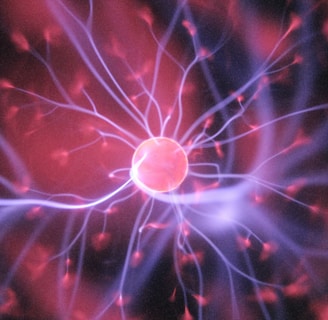Managing Pinched Nerve Discomfort Through Exercises and Stretches
7/27/20255 min read


Understanding Pinched Nerves
A pinched nerve occurs when surrounding tissues, such as bones, muscles, or tendons, exert pressure on a nerve, leading to various uncomfortable sensations and symptoms. This condition can arise in different areas of the body, affecting the neck, back, and limbs. When a nerve is pinched, it can disrupt the normal function of that nerve, resulting in several distinctive signs that individuals may experience.
One of the most common symptoms associated with a pinched nerve is sharp pain in the affected area. This pain may radiate to other regions, such as the arms or legs, particularly if the nerve is located in the spine. Additionally, many individuals report tingling sensations, often described as a "pins and needles" feeling. This can occur when the nerve experiences pressure, causing irregular signals to be sent to the brain.
Numbness is another frequent symptom of a pinched nerve, where individuals may feel a decrease in sensation in the area supplied by the affected nerve. This could lead to difficulty performing daily tasks, as the lack of feeling can reduce coordination. Additionally, muscle weakness is a critical sign indicating that a nerve is pinched; affected muscles may feel impaired or unable to perform effectively, impacting one’s overall mobility.
Several factors can contribute to the development of a pinched nerve. Common causes include herniated discs in the spine, which can bulge outward and press against neighboring nerves. Repetitive motions, such as typing or heavy lifting, often place excessive strain on specific areas, heightening the risk of nerve compression. Poor posture is also a significant contributing factor, as it can lead to abnormal alignment and increased pressure on various nerves throughout the body. Recognizing these symptoms and causes is crucial for understanding the impact of a pinched nerve on one’s health and well-being.
Simple Exercises and Stretches for Relief
Engaging in gentle exercises and stretches can significantly alleviate the discomfort associated with a pinched nerve. It is essential to listen to your body and move within your comfort zone when attempting these movements. Below are some simple yet effective exercises designed to provide relief.
1. Side Bends: This exercise helps relieve tension in the neck and shoulder area. Stand with your feet shoulder-width apart. Place your right hand on your hip and slowly lean to the left, allowing your left arm to reach over your head. Hold this position for 15-30 seconds, feeling the stretch along the right side of your body. Return to the starting position and repeat on the opposite side.
2. Hamstring Stretch: A tight hamstring can contribute to nerve discomfort. To perform this stretch, sit on the floor with your legs extended in front of you. Gradually reach toward your toes while keeping your back straight, aiming to feel a gentle stretch in the back of your thighs. Hold for 15-30 seconds and breathe deeply. Make sure to return to a seated position slowly.
3. Shoulder Shrugs: This exercise is beneficial for alleviating tension in the shoulders. Stand or sit up straight and inhale deeply. As you exhale, lift your shoulders up toward your ears. Hold for a few seconds, then release them back down. Repeat this motion 5-10 times, focusing on relaxing your neck and shoulders with each movement.
4. Chin Extensions: To improve neck mobility, sit or stand again with good posture. Gently tuck your chin to your chest and hold for a few seconds. Next, slowly extend your chin upward, facing the ceiling, and hold that position. Repeat this sequence 5 times, ensuring movements are controlled and smooth.
These exercises and stretches are a beneficial part of alleviating pinched nerve discomfort. By incorporating them into your daily routine, you can enhance your overall comfort and functionality.
Tips for Safe Practice
Engaging in exercises and stretches to alleviate pinched nerve discomfort can be beneficial, yet it is essential to approach these practices with caution. To ensure safety and effectiveness, individuals should consider several key tips when incorporating new routines. First and foremost, starting slowly is fundamental. Gradually introducing exercises allows the body to adapt and minimizes the risk of exacerbating any existing discomfort. It is advisable to begin with gentle movements, gradually increasing intensity as tolerance builds.
Maintaining proper form during exercises is another crucial aspect of safe practice. Incorrect posture or movements can lead to further strain on the affected area, potentially aggravating the symptoms. Individuals should focus on alignment and control while performing each exercise. It may be beneficial to seek guidance from a physical therapist or qualified instructor who can provide valuable insights into proper techniques tailored to one's personal condition.
Furthermore, it is imperative to listen to one's body. Participants should be mindful of any signals indicating increased pain or discomfort. If an exercise causes pain beyond typical stretching sensations, it is wise to stop immediately and assess the situation. Ignoring pain can lead to more severe injuries and setbacks in recovery. Consulting a healthcare professional before starting any new exercise routine is highly recommended, especially for individuals with pre-existing health conditions or severe symptoms. Healthcare providers can offer personalized advice and modifications to ensure safety.
Lastly, integrating mindfulness while exercising can enhance the overall experience. Being present and focusing on bodily sensations can aid in recognizing limits and promote a more profound connection to one's body. This mindful approach can empower individuals, instilling confidence in managing their discomfort effectively through safe and intentional practices.
When to Seek Professional Help
Recognizing the right time to consult a healthcare professional regarding pinched nerve symptoms is crucial for effective management and recovery. While minor discomfort may be attributable to everyday activities or posture, certain symptoms should prompt immediate medical attention. One of the primary indicators is persistent pain that does not alleviate with home treatments such as rest, ice, or over-the-counter medications. If you find that your pain intensifies over time or is accompanied by numbness or tingling sensations, it may signify a more severe underlying issue. Seeking a timely evaluation can facilitate early diagnosis and intervention.
Another significant warning sign to consider is severe weakness in any limb. If you experience difficulty in gripping objects, lifting your arm, or experiencing a noticeable loss of strength in your legs, it is critical to seek professional assessment. Weakness may indicate that the pinched nerve is severely affecting your muscle function, which could lead to long-term complications if not addressed promptly.
Loss of bowel or bladder control is another urgent reason to consult a healthcare provider. These symptoms may suggest that the nerve compression is impacting the spinal cord and requires immediate attention to prevent further complications. Healthcare professionals typically conduct a thorough evaluation, which may include physical examinations and imaging tests, such as MRI scans or X-rays. These diagnostic tools help to ascertain the precise cause and location of the nerve compression.
Treatment options may vary based on severity and can include physical therapy, which focuses on exercises and stretches aimed at alleviating pressure on the affected nerve. Additionally, more invasive interventions, such as corticosteroid injections or surgery, might be recommended if conservative treatments do not yield satisfactory results. It is essential to remain proactive about your symptoms and engage with a healthcare provider to develop an appropriate management plan.



